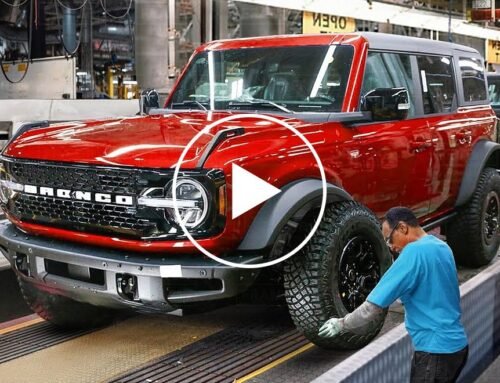The attention to detail here is staggering.
The BMW M3 Touring has been a long time in the making, but it will be worth the wait. Over the past few months, BMW M has been chronicling the process of getting the first-ever M3 wagon to the proof of concept stage, then to board approval, then to design and prototype construction, and finally, testing. Ultimately, this needs to feel like a real M3, which means extensive evaluation and endless hours of development. It also means that the car needs to be constructed to the highest standards, and in the latest entry in BMW M’s journal of the Touring’s journey, we get to see just how a car like this is built.
 BMW M/YouTube
BMW M/YouTube
 BMW
BMW


In this (sixth) episode, we follow Alexander Stojnic around the BMW Plant Munich as he meets with colleagues and discusses each element of the construction process. Stojnic is the Plant Project Lead for the M3 Touring. As you likely already know, 2022 is the year in which BMW M celebrates 50 years of existence, but it also marks 50 years of the BMW company headquarters in the so-called four-cylinder building in Munich. In addition, it has been 100 years since BMW’s main factory has been located in the city. But enough of that, we’re here to see how a pre-series vehicle is built.
 BMW M/YouTube
BMW M/YouTube
 BMW M/YouTube
BMW M/YouTube


As you can imagine, it takes an enormous workforce to produce some of the finest cars on the planet, and according to Stojnic, people from 70 different nations make up that collective. The body shop is highly automated, however, with 1,200 robots joining the 400 individual parts into one body. This is achieved by applying 6,000 spot welds. To further ensure outstanding handling and structural rigidity, “approximately 80 meters [over 262 feet] of adhesive joints” are applied to the car. The body then goes to a geometry cell to ensure dimensional accuracy before more welding is added and missing parts like flanges and welding bolts are added.
 BMW M/YouTube
BMW M/YouTube
 BMW M/YouTube
BMW M/YouTube
 BMW M/YouTube
BMW M/YouTube
 BMW M/YouTube
BMW M/YouTube
Once the body is complete, each construction stage is again checked for geometric accuracy using around 1,700 additional measurements. Matthias Pfanzelt, the Process Lead for Bodywork Finish, explains that, in the body shop finishing department, around 950 bodies are sent to the paint shop every single day. But before paint, the deformation elements (the parts of the car that are meant to crumble to protect you in a crash) are fitted and screwed by torque-checked wrenches. BMW requires very precise joints and offsets, so every panel from the doors to the rear hatch to the M-specific hood is checked by hand to ensure millimetric accuracy. Once this is done, an inspector uses a sensor glove to feel the entire body and ensure that it is free of any dents or other imperfections.
 BMW M/YouTube
BMW M/YouTube
 BMW M/YouTube
BMW M/YouTube
 BMW M/YouTube
BMW M/YouTube
 BMW M/YouTube
BMW M/YouTube
In the paint shop, we learn that, while the new BMW M340i is getting a carbon roof like the M3 sedan, the M3 Touring is simply getting a black contrast roof (likely to save costs). It appears that this will not have a panoramic sunroof fitted to it, saving weight. The roof is painted first, with the rest of the body covered. Once this process is complete, the rest of the body is painted and each surface is inspected.
Next comes the construction of the seats, which will include both the regular sports seats and the M Carbon buckets. The latter seats are made in three steps: in the Dingolfing factory, the leather cover is handsewn before the seat is transported to Munich for pre-assembly, and then final assembly occurs in the production line in hourly cycles before the seats are delivered to the vehicle assembly line.
 BMW M/YouTube
BMW M/YouTube
 BMW M/YouTube
BMW M/YouTube
 BMW M/YouTube
BMW M/YouTube
 BMW M/YouTube
BMW M/YouTube
On the vehicle assembly line, the chassis powertrain is completed and assembled, meaning that the engine, suspension, gearbox, and other chassis and powertrain components are married to the body. The M3-specific bumpers are fitted here too, and because this car will be launched this year, it will be fitted with the M 50 Years Heritage emblem. One floor down, the M-specific exhaust is fitted. A strut package, or so-called thrust field, is then added to enhance rigidity, thereby ensuring excellent handling. Then come the wheels and tires, and the car is finally ready to move on its own power. But it is still not ready for the road.
 BMW M/YouTube
BMW M/YouTube
 BMW M/YouTube
BMW M/YouTube
 BMW M/YouTube
BMW M/YouTube
 BMW M/YouTube
BMW M/YouTube
Before it leaves the factory, the final testing steps begin, with these encompassing headlight and chassis adjustments. Keep in mind that this is still all pertaining to the prototypes. The level of detail and excellence here is truly astounding. Next, the car moves onto the rolling road to test the brakes, gears, and acceleration. Thereafter, the prototype is camouflaged and additional testing equipment is added to “evaluate the electrics and electronics from the customer’s point of view,” which means looking “at the functions in the vehicle that are most relevant for the customer.” These measurement technologies help the engineers isolate any errors that may be encountered during testing, allowing them to determine exactly where the error has occurred.
 BMW M/YouTube
BMW M/YouTube
 BMW M/YouTube
BMW M/YouTube
 BMW M/YouTube
BMW M/YouTube
 BMW M/YouTube
BMW M/YouTube
Finally, the test mule can see the sun, but the testing is not over. Hill starts are simulated, and the “sine wave” road is used to test suspension articulation, for example when driving into underground parking garages, and twisting or body flex, which can occur when driving off a curb. It also guarantees that there are no creaks or rattles, which is again simulated by driving over manhole covers and potholes. Even if it passes all these tests, the car returns indoors to the Hydropulse facility, which vibrates each wheel individually. This recreates the effects of driving over cobblestones or manhole covers, helping the engineers isolate and eliminate any hidden rattles, buzzes, or creaks. After all of this, the car is finally ready for the delivery bay and ultimately Nurburgring testing. The next video will cover the BMW M3 Touring’s official lap time at the iconic circuit, but based on everything we’ve seen today, it’s safe to assume that this will be exactly what it should: a real M3.
 BMW M/YouTube
BMW M/YouTube
 BMW M/YouTube
BMW M/YouTube
 BMW M/YouTube
BMW M/YouTube
 BMW M/YouTube
BMW M/YouTube
 BMW
BMW
 BMW
BMW





